西方礼仪文化unit 7
- 格式:ppt
- 大小:1.61 MB
- 文档页数:10

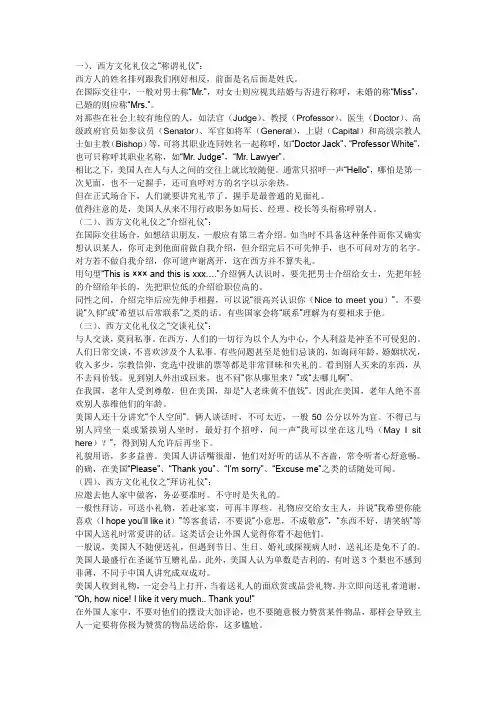
一)、西方文化礼仪之“称谓礼仪”:西方人的姓名排列跟我们刚好相反,前面是名后面是姓氏。
在国际交往中,一般对男士称“Mr.”,对女士则应视其结婚与否进行称呼,未婚的称“Miss”,已婚的则应称“Mrs.”。
对那些在社会上较有地位的人,如法官(Judge)、教授(Professor)、医生(Doctor)、高级政府官员如参议员(Senator)、军官如将军(General),上尉(Capital)和高级宗教人士如主教(Bishop)等,可将其职业连同姓名一起称呼,如“Doctor Jack”、“Professor White”,也可只称呼其职业名称,如“Mr. Judge”,“Mr. Lawyer”。
相比之下,美国人在人与人之间的交往上就比较随便。
通常只招呼一声“Hello”,哪怕是第一次见面,也不一定握手,还可直呼对方的名字以示亲热。
但在正式场合下,人们就要讲究礼节了。
握手是最普通的见面礼。
值得注意的是,美国人从来不用行政职务如局长、经理、校长等头衔称呼别人。
(二)、西方文化礼仪之“介绍礼仪”:在国际交往场合,如想结识朋友,一般应有第三者介绍。
如当时不具备这种条件而你又确实想认识某人,你可走到他面前做自我介绍,但介绍完后不可先伸手,也不可问对方的名字。
对方若不做自我介绍,你可道声谢离开,这在西方并不算失礼。
用句型“This is ××× and this is xxx….”介绍俩人认识时,要先把男士介绍给女士,先把年轻的介绍给年长的,先把职位低的介绍给职位高的。
同性之间,介绍完毕后应先伸手相握,可以说“很高兴认识你(Nice to meet you)”。
不要说“久仰”或“希望以后常联系”之类的话。
有些国家会将“联系”理解为有要相求于他。
(三)、西方文化礼仪之“交谈礼仪”:与人交谈,莫问私事。
在西方,人们的一切行为以个人为中心,个人利益是神圣不可侵犯的。
人们日常交谈,不喜欢涉及个人私事。
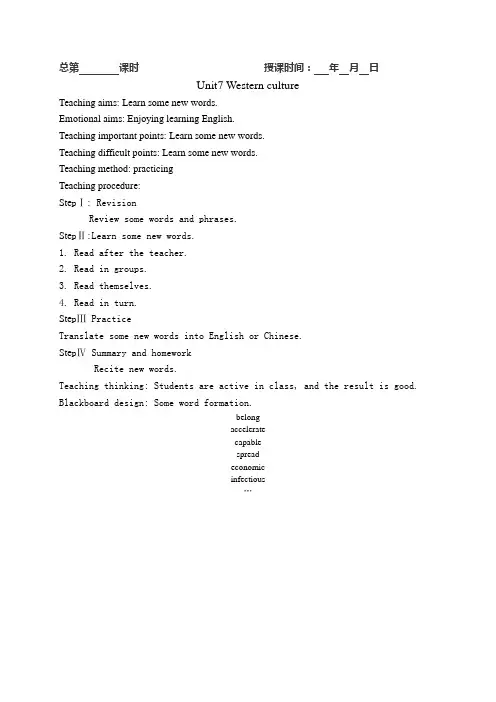
Unit7 Western cultureTeaching aims: Learn some new words.Emotional aims: Enjoying learning English.Teaching important points: Learn some new words.Teaching difficult points: Learn some new words.Teaching method: practicingTeaching procedure:Ste pⅠ: RevisionReview some words and phrases.Ste pⅡ:Learn some new words.1. Read after the teacher.2. Read in groups.3. Read themselves.4. Read in turn.Ste pⅢ PracticeTranslate some new words into English or Chinese.Ste pⅣ Summary and homeworkRecite new words.Teaching thinking: Students are active in class, and the result is good. Blackboard design: Some word formation.belongacceleratecapablespreadeconomicinfectious…Reading Popular musicTeaching aims: 掌握Key words 和Useful expressions的基本用法.Emotional aims: 了解流行音乐.Teaching important points: 理解课文内容,掌握课文的主要知识点.Teaching difficult points: 掌握Key words 和Useful expressions的基本用法.Teaching method: Teaching and practicing.Teaching procedures:Ste pⅠRevision检查学生预习生词和短语的情况.Ste pⅡ1.1.组织讨论Warm up中的3个问题,Do you like popular music?Do you know any western pop singers?Is singing English songs a good way of learning English?2.播放几首著名的英语流行乐曲或歌曲,回答:What kind of music did you hear just now?Can you sing an English pop song?3.讨论课文插图:Who are the four young men?约翰·列侬( John Lennon)、保罗·麦卡特尼(Paul McCartney)、乔治·哈里森( George Harrison)、斯图尔特·苏特克里弗(Stuart Sutcliffe)、彼得·贝斯特(Peter Best) What are they?4.对上述问题可给学生适当的提示,以便了解更多的信息。

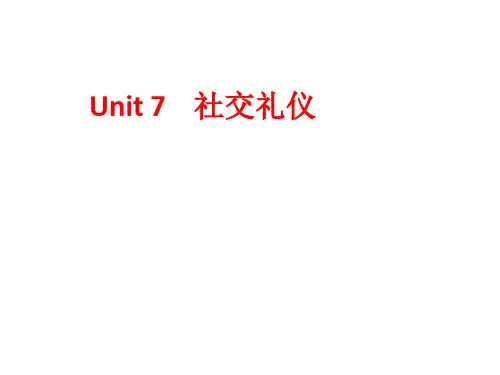
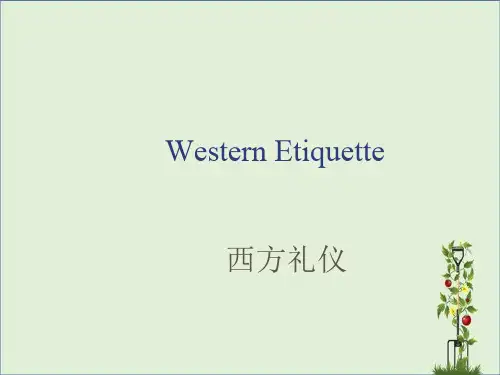

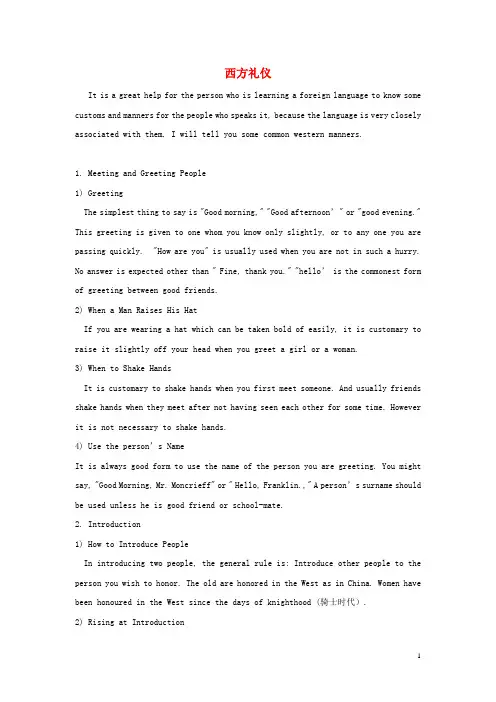
西方礼仪It is a great help for the person who is learning a foreign language to know some customs and manners for the people who speaks it, because the language is very closely associated with them. I will tell you some common western manners.1. Meeting and Greeting People1) GreetingThe simplest thing to say is "Good morning," "Good afternoon’" or "good evening." This greeting is given to one whom you know only slightly, or to any one you are passing quickly. "How are you" is usually used when you are not in such a hurry. No answer is expected other than " Fine, thank you." "hello’ is the commonest form of greeting between good friends.2) When a Man Raises His HatIf you are wearing a hat which can be taken bold of easily, it is customary to raise it slightly off your head when you greet a girl or a woman.3) When to Shake HandsIt is customary to shake hands when you first meet someone. And usually friends shake hands when they meet after not having seen each other for some time. However it is not necessary to shake hands.4) Use the person’s NameIt is always good form to use the name of the person you are greeting. You might say, "Good Morning, Mr. Moncrieff" or " Hello, Franklin.," A person’s surname should be used unless he is good friend or school-mate.2. Introduction1) How to Introduce PeopleIn introducing two people, the general rule is: Introduce other people to the person you wish to honor. The old are honored in the West as in China. Women have been honoured in the West since the days of knighthood (骑士时代).2) Rising at IntroductionA man always rise for an introduction, except that it is sometimes all right for an elderly man to remain seated when a young man is introduced to him. The hostess always rises for an introduction.3) Introducing YourselfIf you want to meet someone, it is better to ask a friend who know him to introduce you. But sometimes at a meeting or gathering it is all right to introduce yourself to a fellow-student, or to one of the same sex and position.3. Invitation1) You Must Reply to an InvitationForeign custom is much more strict than Chinese custom in the matter of replying to invitations. When you receive an invitation you should answer it immediately, saying definitely whether you are able to accept it or not.2) Written or Verbal ReplyIf the invitation is given by word of mouth, in conversation or at a chance meeting, you should answer at once whether you can come or not. If you cannot give an answer at that time, you may say, "May I let you know this evening?" Or some such words.4. In the Home1) The Right Time to ArriveWhen invited to luncheon, dinner, or supper, it is very impolite to arrive late, as it isusually planned to have the meal at the exact hour given in the invitation.2) In arrivalWhen you arrive, the hostess or some member of the family will probably meet you at the door and take your coat and hat. In the winter time you should dress more lightly than usually, as you may expect the rooms to be warmer than in most Chinese homes.3) In a few minutes the hostess will ask her guests to come in to dinner. She may or may not ask each gentleman to take a lady in. If she does, the lady will take the gentleman’s arm as they walk into the dinning room. If she does not, the ladies will go in first, followed by the gentlemen. The hostess will either point out theirseats to the guests as they come in or have a place card at each place with the guests name on it.4) How Long to StayAfter the meal is over it is not polite to leave for at least half an hour, lest you seem to have come only for the meal. An evening dinner invitation usually implies that you stay for the whole evening. The hostess often plans some after-dinner entertainment.5) What to Say on LeavingWhen leaving any kind of a party, a guest always expresses his appreciation to the hostess. Some such words as these are appropriate. "Thank you so much. I’ve had a delight evening."5. Table Manners1) As soon as the hostess picks up her napkin(餐巾), pick yours up and lay it on your lap. Sometimes a roll of bread is wrapped in it; if so, toke it our and put it on your side plate.2) The Soup CourseDinner usually begins with soup. The largest spoon at your place is the soup spoon. It will be beside your plate at the right-hand side.3) The Fish CourseIf there is a fish course, it will probably follow the soup. There may be a special fork for the fish, or it may be similar to the meat fork. Often it is smaller.4) The Meat CourseThe main Course is usually served by the host himself, especially if it is a fowl(鸡禽) or a roast which need to be carved. He will often ask each guest what piece he prefers, and it is quite proper to state your preference as to lean or fat, dark (红肉) or light(白肉).5) Using Knife and ForkIf you have English and American friends you will notice a few differences in their customs of eating. For the main or meat curse, the English keep the fork in the left hand, point curved downward, and bring the food to the mouth either by sticking thepoints onto it or in the case of soft vegetables, by placing it firmly on the fork in this position with the knife. Americans carve the meat in the same position, then lay down the knife and taking the fork in the right hand with the point turned up, push it under a small piece of food without the help of the knife and bring it to the moth right-side-up.。
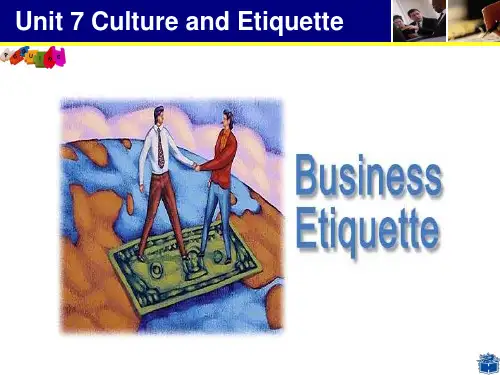
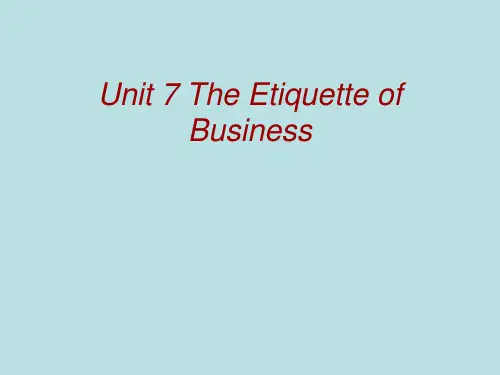
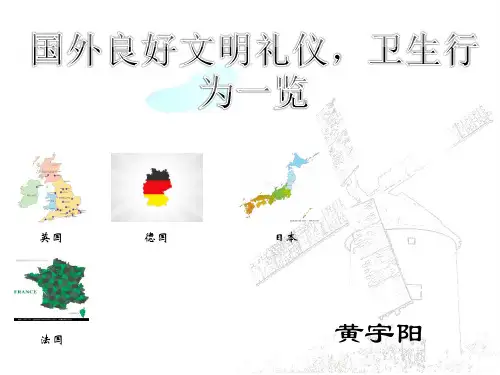
辽宁工程技术大学公共选修课程申请表《中西礼仪文化对比》教学大纲课程名称:中西礼仪文化对比课程性质:选修课学时学分:16学时适用专业:全校非英语专业本科学生一、课程的性质和任务《中西礼仪文化对比》是一门实用性较强的人文类型课程,介绍世界各地区礼仪发展的历程,评价和比较中外礼仪、民族文化在各个时期的不同表现。
它适合各专业学生修读,可以作为文科类的基础课程,也可以作为理工类大学生的必修课程。
该课程主要讲授世界各个主要民族的礼仪发展、演化史,特别是介绍各个主要民族在不同时期的文化表现、意义。
在对高校学生(特别是理工类的大学生)开展素质教育的过程中,本课程具有不可替代的重要作用。
通过本课程的学习,使学生对世界各主要民族和地区礼仪发展的历史脉络有一个总体把握。
希望通过系统学习本课程,使学生充分感受西方一些国家和中国等地区文化发展的重大意义及其深远的影响,同时对这些地区的文化作一比较,以认目前我们自己礼仪所处的阶段,认识到我们当代礼仪与发达国家的差距,深刻反思我们自己,更重要的是,也通过学习我们自己的古代丰富发达的礼仪,增强早已失去的自豪感,以痛定思痛,好好学习,将来为国家建设、为恢复传统文化、为推广旧有的中华礼仪、为树立几乎失去的民族自豪、自尊、自信而努力。
二、课程基本要求及内容(一)课程基本要求设置本课程的目标是为了开拓学生的文化视野和礼仪素养,培养学生面对异域文化的自立能力,为将来胜任工作打下坚实的基础。
本课程要求学生不仅熟悉基本的西方文化与社交礼仪,还要锻炼独立、应变的能力,以便将来快速适应异域的文化差异。
本课程是一门文化知识型,应用型的课程。
1)使学生较深入地了解西方文化,熟悉中国文化,加深对中西方文化体系的认识和比较,增强学生对文化差异的敏感性,以及处理文化差异的灵活性、自觉性2)介绍中西文化传统,风俗习惯,使学生较好地宣传我国文化以增进中西方人们之间的相互了解,从而达到在对外交流过程中准确地理解对方和得体地表达自己。
西方礼仪(5篇模版)第一篇:西方礼仪西方礼仪见面西方人见面,最普通的礼节是握手、问好(如英语,中的“How do you do”)。
但是不能主动向女士伸手,一定要女士主动伸手,方可去握。
女士伸手以后,男士要立即反映,不能迟疑,否则是一种无礼的行为。
如果你戴着帽子,见了英、美人,只要用手触碰帽沿示意即可;若是法国人 ,则须把帽子抬起。
南欧、东欧人见面则比较热情,有拍肩膀、拥抱的举动。
凡初次见面,假如以后准备联系,则要互赠名片,否则就可不必了。
西方人的称呼,一般在姓前冠以先生、夫人、小姐。
有些国家,如德国,很重视职衔、学衔,这些也要加上去。
英语中的“Mr”和“Mrs”是一种普通的称呼,即使对佣仆也用得上,但对有身份的人,则称为“Sir”和“Madam”。
面对非英、美的西方女士,都可称之为“Madam”。
对于西方人,除非很亲密,不能随便直呼其名,只有美国人或年轻人,一旦相识,可以很快互称名字。
(二)在介绍两个人互相认识时的通常做法把他人介绍给你所尊敬的人;把男士介绍给女士;把较年轻的介绍给同性别的较年长者;把未婚女士介绍给已婚女士;把儿童介绍给成年人;把比较次要的人介绍给同性别的较重要的人。
如果介绍自己的配偶 ,应该讲: “我的丈夫”或“我的妻子”。
注意:按中国的习惯恰好相反,中国是:“先尊后卑“”,而西方是“先卑后尊”。
(三)闲谈当和西方朋友同行,途遇另一个朋友,如要停步讲话,应为他们作介绍。
如外国朋友遇见他的朋友而停步讲话,你应很自然地继续向前走几步,以便让外国朋友决定是否给你们作介绍。
与西方女士同行,男士应该走在靠马路一侧,让女士走在较安全的内侧。
同西方人闲谈 ,最好能找共同感兴趣的话题,不要只顾自己夸夸其谈,把别人撂在一边。
德国人喜欢谈体育项目和个人业余爱好,英国人喜欢谈天气……。
除了少数国家如希腊等外,西方人都讨厌大声说话,喜欢安静,也不愿去干扰他人。
同西方人交谈,意见不一时,不要一味去说服对方 ,更不能喧嚷争吵。
Unit 7 Topic 3背景知识西式餐桌礼仪1.各种餐具的用途和用法:(1)主餐盘:放置主菜用,主菜通常由男主人亲自端上桌,然后切开分给每个人,但必须等女主人拿起刀叉,大家才可以开始。
(2)沙拉盘:放置沙拉或开胃菜。
(3)面包盘:放置面包用,取用面包时,以手撕一小块,沾上奶油或果酱食用。
(4)鱼叉、主餐叉:当看见鱼叉、主餐叉由左向右依序放在主餐盘的左边时,表示菜中有鱼类的食物。
(5)鱼刀、主餐刀:鱼肉因肉质松软所以鱼刀的刀面较宽,以利切割时不易松散,在欧式用法中,可以右手持餐刀,左手持餐叉同时取用食物,另一种用法则可以将主菜切开后,用右手持餐叉食用。
(6)酒杯:由右至左依序是白酒杯、甜酒杯、红酒杯,若有水杯则是放在最左边。
前菜通常配用较清淡的白酒,而主菜以红酒佐餐,甜酒在餐后饮用,对法国人来说,若要为其他客人斟酒,得先得到女主人的应允,否则被视为有失礼数的举止。
2.餐桌礼仪:(1)座次:在正式的西餐礼仪中,长桌的两头是大位,愈中间的位置愈是次要的位置,而且男女间隔坐,夫妻分开坐,使得用餐气氛更加热闹。
(2)餐巾:正确的餐巾摆法是将餐巾折成三角形或长方形,折口向外摆在大腿上,若吃饭中途要打电话或上洗手间,可将餐巾放在椅子上。
餐巾放在桌上表示要中途离去或用餐完毕。
(3)刀、叉:刀叉在使用时切勿发出碰撞声及用力切割盘子的刺耳声,若要中途离开一会儿,可将刀叉一右一左朝内放在餐盘上,表示仍要继续食用;若食用完毕,则将刀叉并排放在餐盘上。
(4)汤匙:由内向外舀取,而且不可出声。
(5)餐酒:通常在西餐中不论饮用何种酒,都应由侍者开瓶,连主人都不宜自己去开瓶。
除了一开始主人可举杯感谢大家光临处,均应避免再敬酒,以免打扰别人用餐。
3.饮食文化的不同中西方的饮食方式有很大不同,这种差异对民族性格也有影响。
在中国,任何一个宴席,都是大家团团围坐,共享一席,造成一种团结、礼貌、共趣的气氛,符合我们民族“大团圆”的普遍心态。